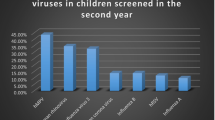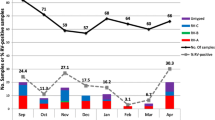Abstract
The purpose of this investigation was to collect information regarding rhinovirus (RV) circulation in children with lower respiratory tract infections (LRTIs) in Burundi, Central Africa. We enrolled all of the children aged between 1 month and 14 years who were admitted to the hospital of Kiremba, North Burundi, with fever and signs and symptoms of LRTI (i.e., cough, tachypnea, dyspnea or respiratory distress, and breathing with grunting or wheezing sounds with rales) between 1 November 2010 and 31 October 2011, and obtained nasopharyngeal swabs for RV detection by means of polymerase chain reaction (PCR). The VP4/VP2 region of the positive samples was sequenced to determine the species of RV (A, B, or C). Four hundred and sixty-two children were enrolled: 160 (34.6 %) with bronchitis, 35 (7.6 %) with infectious wheezing, and 267 (57.8 %) with community-acquired pneumonia (CAP). RV infection was demonstrated in 186 patients [40.3 %; mean age ± standard deviation (SD) 1.77 ± 2.14 years]. RV infection was detected in 78 patients aged <12 months (40.0 %), 102 aged 12–48 months (44.3 %), and six aged >48 months (16.7 %; p < 0.01 vs. the other age groups). The most frequently identified RV was RV-A (81 cases, 43.5 %), followed by RV-C (47, 25.3 %) and RV-B (18, 9.7 %); subtyping was not possible in 40 cases (21.5 %). RV-A was significantly associated with bronchitis and CAP (p < 0.01) and RV-C with wheezing (p < 0.05). In Burundi, RVs are frequently detected in children with LRTIs. RV-A seems to be the most important species and is identified mainly in patients with bronchitis and CAP.


Similar content being viewed by others
References
Price WH (1956) The isolation of a new virus associated with respiratory clinical disease in humans. Proc Natl Acad Sci USA 42:892–896
Krilov L, Pierik L, Keller E, Mahan K, Watson D, Hirsch M et al (1986) The association of rhinoviruses with lower respiratory tract disease in hospitalized patients. J Med Virol 19:345–352
Ramsey BW, Marcuse EK, Foy HM, Cooney MK, Allan I, Brewer D et al (1986) Use of bacterial antigen detection in the diagnosis of pediatric lower respiratory tract infections. Pediatrics 78:1–9
Turner RB, Lande AE, Chase P, Hilton N, Weinberg D (1987) Pneumonia in pediatric outpatients: cause and clinical manifestations. J Pediatr 111:194–200
Cheuk DK, Tang IW, Chan KH, Woo PC, Peiris MJ, Chiu SS (2007) Rhinovirus infection in hospitalized children in Hong Kong: a prospective study. Pediatr Infect Dis J 26:995–1000
Esposito S, Daleno C, Tagliabue C, Scala A, Tenconi R, Borzani I et al (2012) Impact of rhinoviruses on pediatric community-acquired pneumonia. Eur J Clin Microbiol Infect Dis 31:1637–1645
Hayden FG (2004) Rhinovirus and the lower respiratory tract. Rev Med Virol 14:17–31
Mermond S, Zurawski V, D’Ortenzio E, Driscoll AJ, Deluca AN, Deloria-Knoll M et al (2012) Lower respiratory infections among hospitalized children in New Caledonia: a pilot study for the Pneumonia Etiology Research for Child Health project. Clin Infect Dis 54(Suppl 2):S180–S189
Lauber C, Gorbalenya AE (2012) Toward genetics-based virus taxonomy: comparative analysis of a genetics-based classification and the taxonomy of picornaviruses. J Virol 86:3905–3915
Lee SL, Chiu SS, Malik PJ, Chan KH, Wong HS, Lau YL (2011) Is respiratory viral infection really an important trigger of asthma exacerbations in children? Eur J Pediatr 170:1317–1324
Niang MN, Diop OM, Sarr FD, Goudiaby D, Malou-Sompy H, Ndiaye K et al (2010) Viral etiology of respiratory infections in children under 5 years old living in tropical rural areas of Senegal: The EVIRA Project. J Med Virol 82:866–872
O’Callaghan-Gordo C, Bassat Q, Morais L, Díez-Padrisa N, Machevo S, Nhampossa T et al (2011) Etiology and epidemiology of viral pneumonia among hospitalized children in rural Mozambique: a malaria endemic area with high prevalence of human immunodeficiency virus. Pediatr Infect Dis J 30:39–44
Onyango CO, Welch SR, Munywoki PK, Agoti CN, Bett A, Ngama M et al (2012) Molecular epidemiology of human rhinovirus infections in Kilifi, coastal Kenya. J Med Virol 84:823–831
Venter M, Lassaunière R, Kresfelder TL, Westerberg Y, Visser A (2011) Contribution of common and recently described respiratory viruses to annual hospitalizations in children in South Africa. J Med Virol 83:1458–1468
Esposito S, Gasparini R, Bosis S, Marchisio P, Tagliabue C, Tosi S et al (2005) Clinical and socio-economic impact of influenza and respiratory syncytial virus infection on healthy children and their households. Clin Microbiol Infect 11:933–936
Esposito S, Bosis S, Niesters HGM, Tremolati E, Begliatti E, Rognoni A et al (2006) Impact of human coronavirus infections in otherwise healthy children who attended an emergency department. J Med Virol 78:1609–1615
Feigin RD, Cherry JD (eds) (2009) Textbook of pediatric infectious diseases, 6th edn. W.B. Saunders, Philadelphia
World Health Organization (WHO) (2005) Pocket book of hospital care for children. Guidelines for the management of common illnesses with limited resources. WHO Press, Chapter 4.2, pp 72–81
Lu X, Holloway B, Dare RK, Kuypers J, Yagi S, Williams JV et al (2008) Real-time reverse transcription-PCR assay for comprehensive detection of human rhinoviruses. J Clin Microbiol 46:533–539
Savolainen C, Mulders MN, Hovi T (2002) Phylogenetic analysis of rhinovirus isolates collected during successive epidemic seasons. Virus Res 85:41–46
Esposito S, Daleno C, Prunotto G, Scala A, Tagliabue C, Borzani I et al (2012) Impact of viral infections in children with community-acquired pneumonia: results of a study of 17 respiratory viruses. Influenza Other Respi Viruses. doi:10.1111/j.1750-2659.2012.00340.x
Jin Y, Yuan XH, Xie ZP, Gao HC, Song JR, Zhang RF et al (2009) Prevalence and clinical characterization of a newly identified human rhinovirus C species in children with acute respiratory tract infections. J Clin Microbiol 47:2895–2900
Linsuwanon P, Payungporn S, Samransamruajkit R, Posuwan N, Makkoch J, Theanboonlers A et al (2009) High prevalence of human rhinovirus C infection in Thai children with acute lower respiratory tract disease. J Infect 59:115–121
du Prel JB, Puppe W, Gröndahl B, Knuf M, Weigl JA, Schaaff F et al (2009) Are meteorological parameters associated with acute respiratory tract infections? Clin Infect Dis 49:861–868
Simmonds P, McIntyre C, Savolainen-Kopra C, Tapparel C, Mackay IM, Hovi T (2010) Proposals for the classification of human rhinovirus species C into genotypically assigned types. J Gen Virol 91:2409–2419
Peltola V, Jartti T, Putto-Laurila A, Mertsola J, Vainionpää R, Waris M et al (2009) Rhinovirus infections in children: a retrospective and prospective hospital-based study. J Med Virol 81:1831–1838
Xiang Z, Gonzalez R, Xie Z, Xiao Y, Liu J, Chen L et al (2010) Human rhinovirus C infections mirror those of human rhinovirus A in children with community-acquired pneumonia. J Clin Virol 49:94–99
McErlean P, Shackelton LA, Lambert SB, Nissen MD, Sloots TP, Mackay IM (2007) Characterisation of a newly identified human rhinovirus, HRV-QPM, discovered in infants with bronchiolitis. J Clin Virol 39:67–75
Smuts H (2008) Human coronavirus NL63 infections in infants hospitalised with acute respiratory tract infections in South Africa. Influenza Other Respi Viruses 2:135–138
Acknowledgments
This study was supported by a grant from the Italian Ministry of Health (Bando Giovani Ricercatori 2007) and Amici del Bambino Malato (ABM) Onlus.
Conflict of interest
The authors have no conflict of interest to declare.
Author information
Authors and Affiliations
Corresponding author
Rights and permissions
About this article
Cite this article
Esposito, S., Daleno, C., Baggi, E. et al. Circulation of different rhinovirus groups among children with lower respiratory tract infection in Kiremba, Burundi. Eur J Clin Microbiol Infect Dis 31, 3251–3256 (2012). https://doi.org/10.1007/s10096-012-1692-9
Received:
Accepted:
Published:
Issue Date:
DOI: https://doi.org/10.1007/s10096-012-1692-9




